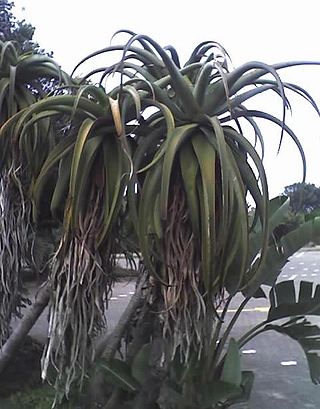
Gonialoe variegata, also known as tiger aloe and partridge-breasted aloe, is a species of flowering plant in the family Asphodelaceae. It is an evergreen succulent perennial indigenous to South Africa and Namibia. It is common in cultivation.

Aloe arborescens, the krantz aloe or candelabra aloe, is a species of flowering succulent perennial plant that belongs to the genus Aloe, which it shares with the well known and studied Aloe vera. The specific epithet arborescens means "tree-like". Aloe arborescens is valued by gardeners for its succulent green leaves, large vibrantly-colored flowers, winter blooming, and attraction for birds, bees, and butterflies.

Aloidendron barberae, formerly Aloe bainesii and Aloe barberae, also known as the tree aloe, is a species of succulent plant in the genus Aloidendron. It is native to South Africa northwards to Mozambique. In its native climes this slow-growing tree can reach up to 60 feet (18 m) high and 36 inches (0.91 m) in stem diameter. An A. barberae planted at the Kirstenbosch Botanical Garden in Cape Town in 1922 had by 2011 grown to have a basal diameter of ten feet. Aloidendron barberae is Africa's largest aloe-like plant. The tree aloe is often used as an ornamental plant. Its tubular flowers are rose pink (green-tipped); it flowers in winter and in its natural environment is pollinated by sunbirds.

Aloe marlothii is a large, single-stemmed Southern African aloe of rocky places and open flat country, occasionally growing up to 6 m tall.

Aloe helenae is a species of plant in the genus Aloe. It is endemic to Madagascar, and is an endangered species.

Aloe maculata, the soap aloe or zebra aloe, is a Southern African species of aloe. Local people in South Africa know it informally as the Bontaalwyn in Afrikaans, or lekhala in the Sesotho language.

Aloe ferox, commonly known as bitter aloe, is a species of flowering plant in the family Asphodelaceae. This woody aloe is indigenous to southern Africa. It is one of several Aloe species used to make bitter aloes, a purgative medication, and also yields a non-bitter gel that can be used in cosmetics.

Aloe africana is an arborescent (tree-like) species of aloe plant, indigenous to the Eastern Cape Province, South Africa.

Aloe thraskii, the dune aloe, is a South African plant in the genus Aloe.

Aloe bakeri is a species of flowering plant in the family Asphodelaceae, native to Madagascar, where it grows on rocky hills at low elevations. Growing to 10–20 cm (4–8 in) tall by 40 cm (16 in) wide, it is an evergreen perennial forming multiple rosettes of spidery succulent green or reddish-green toothed leaves, heavily mottled with white. The leaves are typically 10 cm long and bear straight or slightly curved white teeth that are 1 mm long and about 1-2 mm apart. In summer it produces red or orange, green-tipped tubular flowers. These flowers are attractive to birds, bees, and wasps, and are typically 2 cm long, borne on racemes 30 cm tall.

Aloe rupestris is an arborescent aloe indigenous to summer-rainfall areas of southern Africa.

Aloe purpurea is a species of Aloe endemic to the island of Mauritius, in the Indian Ocean, where it formerly occurred on dry rocky slopes and outcrops, the highland plateaus, and the forests of the west. It is part of a group of aloes which bear fleshy berries, and were therefore classed as a separate group, "Lomatophyllum". It is also one of only two Aloe species which naturally occur on Mauritius - both endemic and occurring nowhere else.

Aloe macra is a species of Aloe endemic to the island of Réunion, in the Indian Ocean.

Aloe lateritia is an aloe widespread in open grassland and rocky bushland of East Africa.

Aloe elegans is a species of plant. It is found in West Sudan, Eritrea to Central Ethiopia

Aloe ikiorum is a species of Aloe native to northeast Uganda. The name references the Ik people indigenous to the area.

Aloe tororoana is a species of Aloe native to southeast Uganda.

Aloe djiboutiensis is a species of aloe native to Djibouti and Eritrea. It was first described in 2007 in the CSSA Journal by T. A. McCoy.

Aloe montis-nabro is a species of Aloe native to the slopes of Mt. Nabro in Eritrea described in 2014 in the CactusWorld journal by Orlando and El Azzouni.

Aloe ambigens is a rare aloe native to Somalia, but only one locality in the Mudug region is currently known.




















